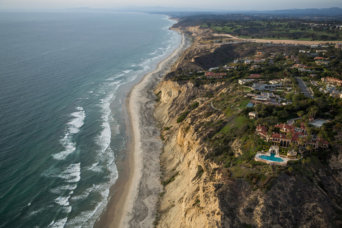- About
- Topics
- Story
- In-Depth
- Picks
- Opinion
- News
- Donate
- Signup for our newsletterOur Editors' Best Picks.Send
Read, Debate: Engage.
The war for freshwater might sound a bit sci-fi, but it's already underway. What's more, it's a total war; everyone is affected, no matter how far away the battlegrounds may be. California is a key site and might point the way to how this war will be fought across the world in the future.
Drought has blighted the Western state many times before, but California has never had the motivation, money or public consensus to convert seawater into drinking water before. That is, until now. The New York Times has followed up on reports that the state was exploring desalination measures with confirmation that the plant being built in Carlsbad is nearing completion, and will be the largest such plant in the Western hemisphere.
Desalination is a global industry, and is growing. Some 15,000 plants are already active, mostly small-scale ones which serve relatively small communities, though there are instances of entire nations being reliant on the process, such as Israel. And while the benefits of reverse osmosis (the method being used to remove salt and impurities from water) are fairly obvious (drinking water, water for agriculture, an enormous supply of water to begin with) the disadvantages are not only myriad, but complex and dangerous.
Firstly, before you ask, yes, desalination is costly. As a resident of Carlsbad, you can expect to pay about $170.00 per month for your water bill, which is way above the national average. Fine, you think, at least there'll be water to drink. Now, let's move on.
One of the main problems associated with desalination is the tremendous amount of energy required to treat the water in the first place. Part of the reverse osmosis method involves forcing the water through semi-permeable polymer membranes which separate the salt molecules from that good old H20. 2.8 kilowatt-hours per cubic meter is what it takes to produce drinking water using the desalination method. That's about seven times the amount of energy needed to produce safe drinking water from a river or a lake.
Still, you think, there'll be water to drink.
Ok, how about the positive feed-back loop this will engender? Water scarcity produced by global warming will be tackled by a method which produces water at a huge cost to the environment, leading to greater water scarcity?
Furthermore, improvements to the technology which would cut cost and energy use look years away from being effective and implemented. To install the technology to save sealife from being obliterated in the process is also costly, and many plants opt not to take such measures.
There are other problems, involving environmental waste, and the potential for desalination plants to become redundant quickly, once droughts have ended. This may not look like an outright war over water, but it's certainly an important strategic move on warming planet, where over 700 million people already face water shortages. But what else is there to do if there's not enough water to drink?
Image: New York Times
